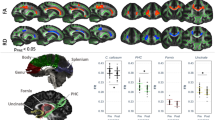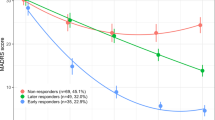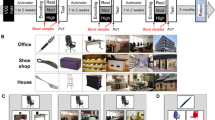Abstract
The antidepressants, reboxetine and citalopram, were used in conjunction with voluntary physical exercise (wheel running) in order to assess the contribution of noradrenergic and serotonergic activation to enhancements in hippocampal brain-derived neurotrophic factor (BDNF) expression resulting from antidepressant treatment and exercise. Reboxetine (40 mg/kg/day), citalopram (10 mg/kg/day), voluntary physical activity, and the combination of antidepressants with exercise were applied to rats for a range of treatment intervals (2 to 14 days). Hippocampal BDNF transcription levels (full-length BDNF, as well as exons I–IV) were then assessed via in situ hybridization.Reboxetine treatment led to a rapid (evident at 2 days) enhancement in BDNF transcription in several hippocampal regions. This increase was also observed when reboxetine treatment was combined with voluntary physical activity for 2 weeks. Treatment with citalopram led to an increase in BDNF mRNA in only one hippocampal region (CA2) after short-term (2 days) treatment, and when combined with exercise, increased BDNF mRNA in the CA4 and dentate gyrus after 2 weeks. As reported in previous studies, voluntary physical activity enhanced BDNF transcription in several hippocampal areas, both on its own and in combination with antidepressant treatments. Examination of the levels of individual BDNF transcript variants influenced by each of these antidepressants revealed distinct patterns of expression in response to the various treatments, and showed that exercise-plus-antidepressant produced significant changes where antidepressant alone failed. Overall, treatment with the norephinephrine-selective antidepressant, reboxetine, in combination with exercise, led to both rapid and sustained increases in hippocampal BDNF mRNA expression. The serotonergic agent, citalopram, appeared to require longer treatment intervals in order to influence BDNF expression positively.
Similar content being viewed by others
Log in or create a free account to read this content
Gain free access to this article, as well as selected content from this journal and more on nature.com
or
References
Aliaga E, Arancibia S, Givalois L, Tapia-Arancibia L (2002). Osmotic stress increases brain-derived neurotrophic factor messenger RNA expression in the hypothalamic supraoptic nucleus with differential regulation of its transcripts. Relation to arginine-vasopressin content. Neuroscience 112: 841–850.
Andreoli V, Carbognin G, Abati A, Vantini G (1999). Reboxetine in the treatment of depression in the elderly: pilot study. J Geriatr Psychiatry Neurol 12: 206–210.
Berchtold NC, Oliff HS, Isackson P, Cotman CW (1997). Brain-derived neurotrophic factor (BDNF) shows a circadian pattern of expression in the hippocampal formation. Soc Neurosic Abstr 23: 46.
Bohmaker K, Eison AS, Yocca FD, Meller E (1993). Comparative effects of chronic 8-OH-DPAT, gepirone and ipsapirone treatment on the sensitivity of somatodendritic 5-HT1A autoreceptors. Neuropharmacology 32: 527–534.
Bradford LD, Tulp MT, Schipper J (1987). Biochemical effects in rats after acute and long-term treatment with clovoxamine. Arch Int Pharmacodyn Ther 287: 188–202.
Campisi J, Leem TH, Greenwood BN, Hansen MK, Moraska A, Higgins K, Smith TP, Fleshner M et al (2003). Habitual physical activity facilitates stress-induced HSP72 induction in brain, peripheral, and immune tissues. Am J Physiol 284: R520–R530.
Carro E, Trejo JL, Busiguiana S, Torres-Aleman I et al (2001). Circulating insulin-like growth factor I mediates the protective effects of physical exercise against brain insults of different etiology and anatomy. J Neurosci 21: 5678–5684.
Cryan JF, Markou A, Lucki I (2002). Assessing antidepressant activity in rodents: recent developments and future needs. Trends Pharmacol Sci 23: 238–245.
Detke MJ, Johnson J, Lucki I (1997). Acute and chronic antidepressant drug treatment in the rat forced swimming test model of depression. Exp Clin Psychopharmacol 5: 107–112.
Dey S, Singh RH, Dey PK (1992). Exercise training: significance of regional alterations in serotonin metabolism of rat brain in relation to antidepressant effect of exercise. Physiol Behav 52: 1095–1099.
Dias BG, Banerjee SB, Duman RS, Vaidya VA (2003). Differential regulation of brain derived neurotrophic factor transcripts by antidepressant treatments in the adult rat brain. Neuropharmacology 45: 553–563.
Dishman RK (1997). Brain monoamines, exercise, and behavioral stress: animal models. Med Sci Sports Exerc 29: 63–74.
Dishman RK, Renner KJ, White-Welkley JE, Burke KA, Bunnell BN (2000). Treadmill exercise training augments brain norepinephrine response to familiar and novel stress. Brain Res Bull 52: 337–342.
Duman RS (1998). Novel therapeutic approaches beyond the serotonin receptor. Biol Psychiatry 44: 324–335.
Duman RS, Heninger GR, Nestler EJ (1997). A molecular and cellular theory of depression. Arch Gen Psychiatry 54: 597–606.
Dunn AL, Reigle TG, Youngstedt SD, Armstrong RB, Dishman RK (1996). Brain norepinephrine and metabolites after treadmill training and wheel running in rats. Med Sci Sports Exerc 28: 204–209.
Fordyce DE, Wehner JM (1993). Physical activity enhances spatial learning performance with an associated alteration in hippocampal protein kinase C activity in C57BL/6 and DBA/2 mice. Brain Res 619: 111–119.
Garcia C, Chen MJ, Garza AA, Cotman CW, Russo-Neustadt A (2003). The influence of specific noradrenergic and serotonergic lesions on the expression of hippocampal brain-derived neurotrophic factor transcripts following voluntary physical activity. Neuroscience 119: 721–732.
Gravel P, de Montigny C (1987). Noradrenergic denervation prevents sensitization of rat forebrain neurons to serotonin by tricyclic antidepressant treatment. Synapse 1: 233–239.
Greenwood BN, Foley TE, Day HE, Campisi J, Hammack SH, Campeau S et al (2003). Freewheel running prevents learned helplessness/behavioral depression: role of dorsal raphe serotonergic neurons. J Neurosci 23: 2889–2898.
Hill RD, Storandt M, Malley M (1993). The impact of long-term exercise training on psychological function in older adults. J Gerontol 48: 12–17.
Ivy AS, Rodriguez FG, Garcia C, Chen MJ, Russo-Neustadt AA (2003). Noradrenergic and serotonergic blockade inhibits BDNF mRNA activation following exercise and antidepressant. Pharmacol Biochem Behav 75: 81–88.
Kuroda Y, McEwen BS (1998). Effect of chronic restraint stress and tianeptine on growth factors, growth-associated protein-43 and microtubule-associated protein 2 mRNA expression in the rat hippocampus. Brain Res Mol Brain Res 59: 35–39.
Labbe EE, Welsh MC, Delaney D (1988). Effects of consistent aerobic exercise on the psychological functioning of women. Percept Mot Skills 67: 919–925.
Lauterborn JC, Rivera S, Stinis CT, Hayes VY, Isackson PJ, Gall CM (1996). Differential effects of protein synthesis inhibition on the activity-dependent expression of BDNF transcripts: evidence for immediate-early gene responses from specific promoters. J Neurosci 16: 7428–7436.
Lloyd KG, Thuret F, Pilc A (1985). Upregulation of gamma-aminobutyric acid (GABA) B binding sites in rat frontal cortex: a common action of repeated administration of different classes of antidepressants and electroshock. J Pharmacol Exp Ther 235: 191–199.
Lucki I (1998). The spectrum of behaviors influenced by serotonin. Biol Psychiatry 44: 151–162.
Marmigere F, Givalois L, Rage F, Arancibia S, Tapia-Arancibia L (2003). Rapid induction of BDNF expression in the hippocampus during immobilization stress challenge in adult rats. Hippocampus 13: 646–655.
Massana J (1998). Reboxetine versus fluoxetine: an overview of efficacy and tolerability. J Clin Psychiatry 59 (Suppl 14): 8–10.
Molteni R, Ying Z, Gomez-Pinilla F (2002). Differential effects of acute and chronic exercise on plasticity-related genes in the rat hippocampus revealed by microarray. Eur J Neurosci 16: 1107–1116.
Montgomery SA (1999). Predicting response: noradrenaline reuptake inhibition. Int Clin Psychopharmacol 14 (Suppl 1): S21–S26.
Montgomery SA, Schatzberg AF (1998). Introduction. Reboxetine: a new selective antidepressant for the treatment of depression. J Clin Psychiatry 59 (Suppl 14): 3.
Morgan WP (1985). Affective beneficence of vigorous physical activity. Med Sci Sports Exerc 17: 94–100.
Nawa H, Carnahan J, Gall C (1995). BDNF protein measured by a novel enzyme immunoassay in normal brain and after seizure: partial disagreement with mRNA levels. Eur J Neurosci 7: 1527–1535.
Nibuya M, Nestler EJ, Duman RS (1996). Chronic antidepressant administration increases the expression of cAMP response element binding protein (CREB) in rat hippocampus. J Neurosci 16: 2365–2372.
Nibuya M, Morinobu S, Duman RS (1995). Regulation of BDNF and trkB mRNA in rat brain by chronic electroconvulsive seizure and antidepressant drug treatments. J Neurosci 15: 7539–7547.
Page ME, Brown K, Lucki I (2003). Simultaneous analyses of the neurochemical and behavioral effects of the norepinephrine reuptake inhibitor reboxetine in a rat model of antidepressant action. Psychopharmacology (Berl) 165: 194–201.
Russo-Neustadt A (2003). Brain-derived neurotrophic factor, behavior, and new directions for the treatment of mental disorders. Semin Clin Neuropsychiatry 8: 109–118.
Russo-Neustadt A, Beard RC, Cotman CW (1999). Exercise, antidepressant medications, and enhanced brain derived neurotrophic factor expression. Neuropsychopharmacology 21: 679–682.
Russo-Neustadt A, Ha T, Ramirez R, Kesslak JP (2001). Physical activity-antidepressant treatment combination: impact on brain-derived neurotrophic factor and behavior in an animal model. Behav Brain Res 120: 87–95.
Russo-Neustadt AA, Beard RC, Huang YM, Cotman CW (2000). Physical activity and antidepressant treatment potentiate the expression of specific brain-derived neurotrophic factor transcripts in the rat hippocampus. Neuroscience 101: 305–312.
Samorajski T, Delaney C, Durham L, Ordy JM, Johnson JA, Dunlap WP (1985). Effect of exercise on longevity, body weight, locomotor performance, and passive-avoidance memory of C57BL/6J mice. Neurobiol Aging 6: 17–24.
Sanchez C, Hyttel J (1999). Comparison of the effects of antidepressants and their metabolites on reuptake of biogenic amines and on receptor binding. Cell Mol Neurobiol 19: 467–489.
Sapolsky RM (2000). The possibility of neurotoxicity in the hippocampus in major depression: a primer on neuron death. Biol Psychiatry 48: 755–765.
Smith MA, Makino S, Kvetnansky R, Post RM (1995). Stress and glucocorticoids affect the expression of brain-derived neurotrophic factor and neurotrophin-3 mRNAs in the hippocampus. J Neurosci 15 (Part 1): 1768–1777.
Timmusk T, Palm K, Metsis M, Reintam T, Paalme V, Saarma M et al (1993). Multiple promoters direct tissue-specific expression of the rat BDNF gene. Neuron 10: 475–489.
Tse WS, Bond AJ (2002). Difference in serotonergic and noradrenergic regulation of human social behaviours. Psychopharmacology (Berl) 159: 216–221.
van Praag H, Kempermann G, Gage FH (1999). Running increases cell proliferation and neurogenesis in the adult mouse dentate gyrus. Nat Neurosci 2: 266–270.
Acknowledgements
This work was supported by PHS Grant MH-59776 and NARSAD Young Investigator Award to ARN, Minority Biomedical Research Support Program to CG, and Arnold and Mabel Beckman Scholars Program to ASI. We thank Irwin Lucki, PhD for valuable comments during the preparation of this manuscript. We also thank Pharmacia Corp. for providing reboxetine for this study, and Lundbeck for providing citalopram.
Author information
Authors and Affiliations
Corresponding author
Rights and permissions
About this article
Cite this article
Russo-Neustadt, A., Alejandre, H., Garcia, C. et al. Hippocampal Brain-Derived Neurotrophic Factor Expression Following Treatment with Reboxetine, Citalopram, and Physical Exercise. Neuropsychopharmacol 29, 2189–2199 (2004). https://doi.org/10.1038/sj.npp.1300514
Received:
Revised:
Accepted:
Published:
Issue date:
DOI: https://doi.org/10.1038/sj.npp.1300514
Keywords
This article is cited by
-
Exploring the Therapeutic Effect of Neurotrophins and Neuropeptides in Neurodegenerative Diseases: at a Glance
Molecular Neurobiology (2023)
-
Winning The Game Against Depression: A Systematic Review of Video Games for the Treatment of Depressive Disorders
Current Psychiatry Reports (2022)
-
Leptin regulates exon-specific transcription of the Bdnf gene via epigenetic modifications mediated by an AKT/p300 HAT cascade
Molecular Psychiatry (2021)
-
Modulation of DNA Methylation and Gene Expression in Rodent Cortical Neuroplasticity Pathways Exerts Rapid Antidepressant-Like Effects
Molecular Neurobiology (2021)
-
Contralateral conditioning to the soleus H-reflex as a function of age and physical activity
Experimental Brain Research (2016)



